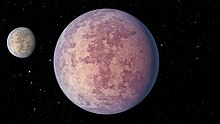HD 260655
| Observation data J2000
| |
|---|---|
| Constellation | Gemini |
| Right ascension | 06h 37m 10.79880s[1] |
| Declination | +17° 33′ 53.3332″[1] |
| Apparent magnitude (V) | 9.77±0.11[2] |
| Characteristics | |
| Evolutionary stage | Main sequence |
| Spectral type | M0.0V[2] |
| Apparent magnitude (B) | 11.10±0.07[2] |
| Apparent magnitude (V) | 9.77±0.11[2] |
| Apparent magnitude (G) | 8.878±0.003[2] |
| Apparent magnitude (J) | 6.674±0.024[2] |
| Apparent magnitude (H) | 6.031±0.016[2] |
| Apparent magnitude (K) | 5.862±0.024[2] |
| Details Gyr | |
| Database references | |
| SIMBAD | data |
HD 260655 (also known as GJ 239 or TOI-4599)[2] is a relatively bright and cool M0 V red dwarf star located 33 light-years (10 parsecs) away from the Solar System in the constellation of Gemini. HD 260655 has two confirmed rocky planets, named HD 260655 b[4][5] and HD 260655 c, that were discovered in 2022. Both planets were detected by the TESS mission and confirmed independently with archival and new precise radial velocity data obtained with the HIRES observatory since 1998, and the CARMENES survey instruments since 2016.[2]
Star
The
Planetary system

The
Both planets are ideal candidates for future study of exoplanet atmospheres due to their closeness and their bright red dwarf star. However, as of 2022, there is no evidence that HD 260655 b or HD 260655 c have atmospheres.[7] HD 260655 is also the fourth-closest known system with multiple transiting exoplanets, after HD 219134, LTT 1445, and AU Microscopii.[8]
| Companion (in order from star) |
Mass | Semimajor axis (AU) |
Orbital period (days) |
Eccentricity | Inclination | Radius |
|---|---|---|---|---|---|---|
| b | 2.14±0.34 M🜨 | 0.02933±0.00024 | 2.76953±0.00003 | 0.039+0.043 −0.023 |
87.35±0.14° | 1.240±0.023 R🜨 |
| c | 3.09±0.48 M🜨 | 0.04749±0.00039 | 5.70588±0.00007 | 0.038+0.036 −0.022 |
87.79±0.08° | 1.533+0.051 −0.046 R🜨 |
References
- ^ S2CID 244398875. Gaia DR3 record for this source at VizieR.
- ^ S2CID 248300168.
- ^ a b "HD 260655". SIMBAD. Centre de données astronomiques de Strasbourg. Retrieved 2022-07-31.
- ^ "The Extrasolar Planet Encyclopaedia — HD 260655 c". Extrasolar Planets Encyclopaedia. Retrieved 2022-07-01.
- ^ Carter, Jamie. "Found: Two New Rocky, Earth-Sized Planets In Our Cosmic Backyard—And There Could Be More". Forbes. Retrieved 2022-07-01.
- ^ a b Brennan, Pat. "Discovery Alert: Two New, Rocky Planets in the Solar Neighborhood". Exoplanet Exploration: Planets Beyond our Solar System. Retrieved 2022-07-01.
- ^ "Two rocky super-Earths discovered just 33 light-years away". Digital Trends. 2022-06-19. Retrieved 2022-07-01.
- ^ "Two Rocky Exoplanets Found Orbiting Bright Red Dwarf | Sci-News.com". Breaking Science News | Sci-News.com. 10 May 2022. Retrieved 2022-07-01.
